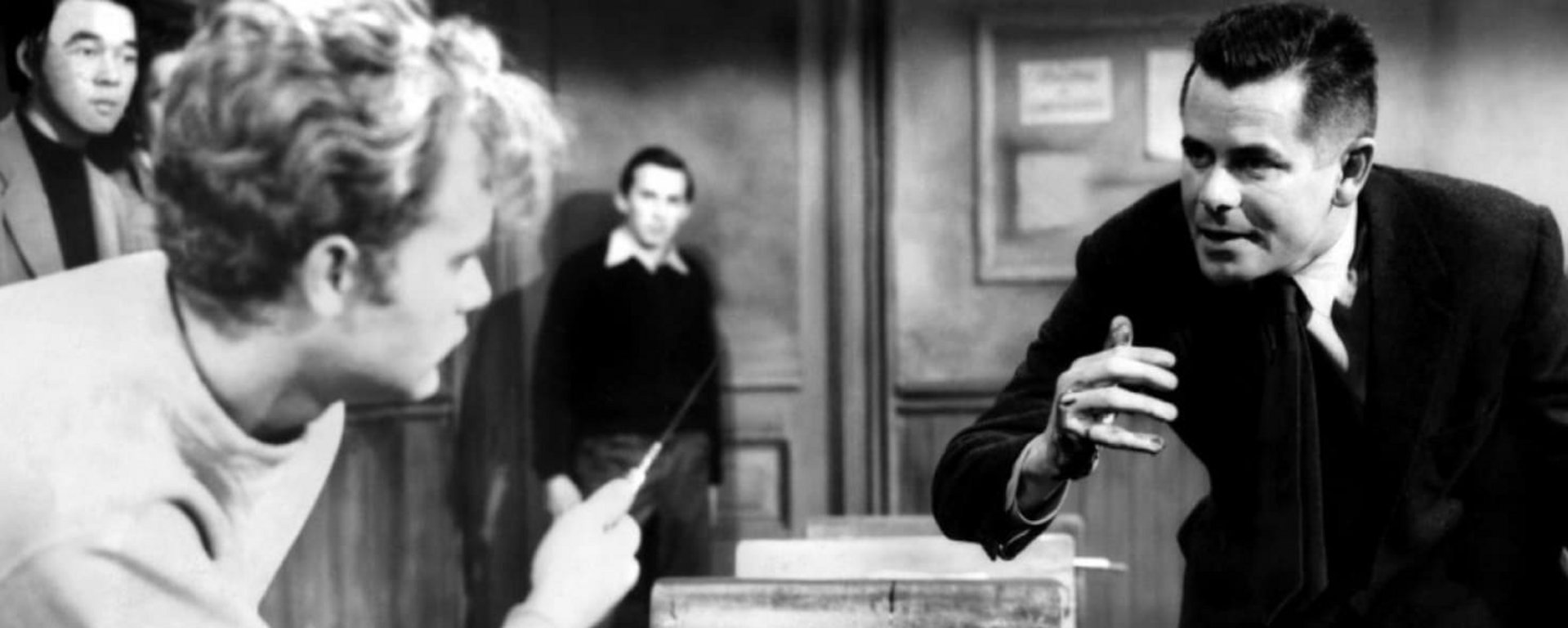
Blackboard Jungle
The 1950s in the UK saw the end of rationing and a gradual increase in prosperity for those who, as Prime Minister Macmillan stated, ‘have never had it so good’. One result of this apparent affluence was the emergence of 'youth' as a group with a defined identity, and as a target for consumer goods; young people with disposable income became an attractive proposition for those selling records, clothes and all the trappings of the teenager.
Controversial subjects on film were accommodated under the new X category, introduced in 1951, and, as the growth of television ownership eroded the adult/family cinema audience, films aimed at the growing youth market attracted teenage audiences.
However, concerns about what were known as juvenile delinquents led the BBFC to reject Laslo Benedek's The Wild One, which it described as 'a spectacle of unbridled hooliganism', in January 1954. The film remained banned until 1967, when the dangers associated with its release were judged to be over.
In March 1955, Richard Brooks’ Blackboard Jungle, which also dealt with juvenile delinquency, was submitted to the BBFC. Based on Evan Hunter’s novel, the film followed the progress of dedicated teacher Richard Dadier who starts his first job teaching a class of tough teenagers at a New York high school. Dadier meets hostility from both his students, who include switchblade-wielding Artie West and the smarter Gregory Miller, and the ineffectual school faculty. Determined to remain in his post, educate his students and exert discipline, Dadier faces an increasingly violent response from some of the class.
The first team of BBFC examiners acknowledged that the film was ‘well-made and well acted’, finding it tense and generally convincing. However, they also thought the violence ‘quite revolting’ and the focus on some of the male pupils’ violent behaviour consequently led the examiners to recommend rejection, for similar reasons as The Wild One. This view was unanimously endorsed when the film was subsequently viewed by the Board’s President Sir Sidney Harris, its Secretary Arthur Watkins and two other examiners.
Arthur Watkins wrote to the film’s UK distributor, explaining that the BBFC would not pass any film ‘dealing with juvenile delinquency or irresponsible juvenile behaviour’ unless the morality of the film was ‘sufficiently strong and powerful to counteract the harm that may be done by the spectacle of youth out of control’.
He also stated that the film, ‘filled as it is with scenes of unbridled, revolting hooliganism’, would be broadly unacceptable to a public already concerned about juvenile delinquency and said it ‘would also have the most damaging and harmful effect’ on older teenagers who would be able to see it if it were given an X certificate. This decision was reaffirmed in a meeting with a distributor’s representative, following which Watkins noted that ‘no amount of cutting would make a certificate practicable’.
Following further representations by the distributor, the film was viewed again. This time, Watkins and a colleague considered the possibility of ‘passing the film with substantial cuts’ as they felt the film possessed ‘artistic merits’ and, more importantly, a ‘moral element which was wholly lacking in The Wild One’. However, Sir Sidney Harris and another examiner believed the rejection should stand. There was a fourth viewing which included the remaining two examiners who had not previously seen the film, and this resulted in an even split between those favouring outright rejection and those cutting the film for an X certificate. This deadlock meant that the BBFC was unwilling to reverse its earlier decision, leaving it up to the distributor to decide whether to submit a cut version for reconsideration.
A distributor’s representative met Watkins, telling him that the BBFC was being ‘quite unreasonable’. The representative claimed the film was sincere and serious in the manner it addressed a pressing social concern, indicated that the distributor would definitely appeal the decision to the local authorities who had the power to overrule the BBFC, and asked the Board to reconsider its decision.
Sir Sidney Harris wrote back to the distributor. He explained that if the film were passed X uncut the BBFC would be exposing itself ‘to serious public criticism’ and that this would also expose the distributor and industry to ‘injurious’ criticism’. Harris acknowledged that the Board felt that ‘apart from the theme’, the film was ‘a good piece of cinema’ and offered a possible compromise of ‘substantial cuts’ which might allow the Board to pass a heavily modified version of the film.
As a result, Watkins viewed the film again and drafted an extensive cuts list intended to reduce the emphasis on the pupils’ delinquent activities. The cuts included removal of the foreword; sight of the male pupils leering at women and a boy assaulting a female teacher; scenes of Dadier being attacked and being threatened by a pupil wielding a knife; the planning and execution of a van robbery; a sequence showing a male teacher’s record collection being destroyed by pupils; and a scene showing Dadier fighting back against a pupil. Following some negotiation with the distributor, a cut version was passed X.
Prior to the film’s UK release, Clare Boothe Luce, the US Ambassador to Italy, intervened to prevent the showing of the film at the Venice Film Festival, as she believed that it presented an inaccurately violent and negative portrayal of her country and its schools. She threatened to boycott the festival, and the film was consequently withdrawn. However, in the UK the official response was more muted as no local authorities who viewed the film chose to ban it. The critical response was mixed, with some reviewers feeling the Board should have rejected the film outright, but the film’s release generally passed without incident and the BBFC received very little public feedback.
Blackboard Jungle was submitted for video classification in 1994 and the passage of time had dulled its original impact such that its presentation of criminal behaviour and violence was acceptable at 12 uncut.